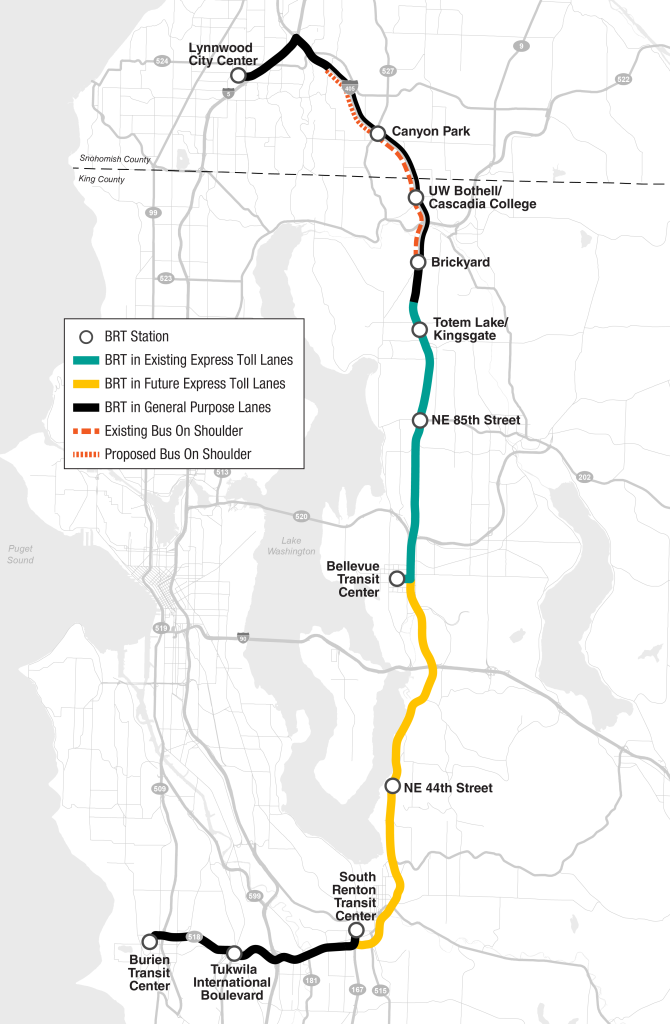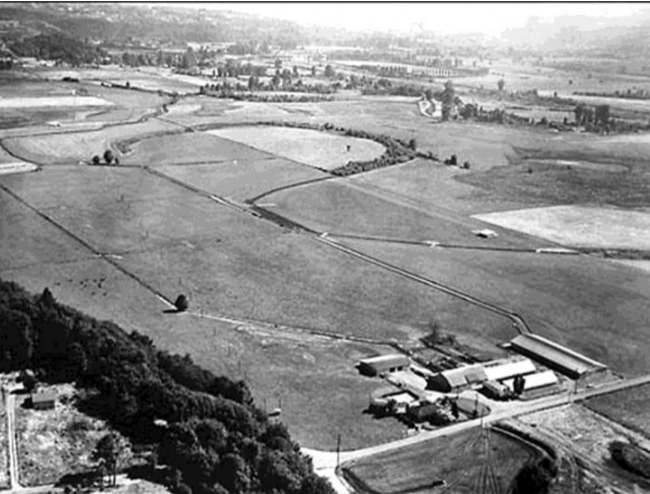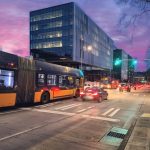Can a sprawling mall become an urban oasis?
Our Seattle region is growing up. New skyscrapers loom over where humble abodes once stood. New buildings rise seemingly by the day, transforming our urban fabric for better or for worse. The Puget Sound Regional Council (PSRC) estimates that we’ll meet one million new neighbors by 2040—there’s no question that accommodating such growth will be a daunting task.
But while our region’s population grows, so too do our inequalities. We’ll need to build an estimated 244,000 units of affordable housing by 2040 in King County alone to ensure that every one of our friends and neighbors has a safe and healthy home they can afford. To make room for everyone, we’ll have to use every bit of our land efficiently, building homes where there are none and adding units to where there are few.
Parking lots are perhaps the most inefficient way we can use land. Not only do they provide housing for zero people, but they’re also inherently car-oriented, ugly, pollution sinks, and an overall terrible waste of space. By redeveloping them, we’ll be to transform them into sustainable, diverse, and equitable communities.
The sheer size of parking lots (and the strip malls they accompany) makes them excellent candidates for redevelopment, and as such would be largely inoffensive. Little to no residents would be displaced in the process and the businesses that are affected can be easily reintegrated into developments that replace them.
The Northgate Mall used to be one of the worst offenders of parking lot land-wasting in our region until we began the process of replacing it with much better higher-density transit-oriented development. The Bellevue Square mall was also up there, but it too is being replaced by higher-density walkable developments. But the Southcenter Mall continues to be a parking wasteland–despite some commercial infill attempts in recent years–and will likely do so for the foreseeable future.
It’s a real shame that the Southcenter area isn’t slated for change since it actually has a lot of potential. For starters, the land is uniquely massive and contiguous. Unlike typical strip malls that cling beside highways for miles (similar to a river’s shoreline), Southcenter is much more spread out. That means we’ll be able to cluster buildings together and ensure walkability similar to a downtown core. There’s numerous quality transit connections, too, such as King County Metro’s 128, 150, and 156 buses to West Seattle, Downtown Seattle and Kent, and Des Moines, respectively, along with the RapidRide F Line which provides a short hop to Renton and Burien. Plus, Sounder commuter rail is just an arm’s reach away. All this means that if Southcenter were to be the home of transit-oriented development (TOD) and mixed-use housing, residents would enjoy convenient access to many of their destinations from day one.
Indeed, the city of Tukwila (in which Southcenter is located) did have ambitious plans for Southcenter’s redevelopment back in 2014. In what was dubbed as the “Tukwila Urban Center,” several districts were proposed, including a Regional Center district and a TOD neighborhood. The former included significant infill development on Southcenter Mall property and the latter focused on building a mix of housing, office, lodging and supportive retail. Supporting both was a comprehensive overhaul of the street network. The plan was adopted into the Comprehensive Plan and development regulations.

While the bold plan itself has not yet materialized in redevelopment, we still have the chance to realize the dreams of TOD it set forth–our fully-funded I-405 bus rapid transit (BRT) line skirts right along the northern edge of Southcenter. We could make it stop there too.

Currently, the nearest BRT stop is more than two miles away from Southcenter, which is quite weird given the density of businesses and jobs there. Even more perplexingly, the Washington State Department of Transportation (WSDOT) and Sound Transit are proposing to add a brand-new stop at the Newport Hills Park-and-Ride which would likely serve far fewer riders than a stop at Southcenter. Sound Transit’s 566 and 567 buses even bypass the Newport Hills stop due to delays and low ridership. Luckily the Newport Hills BRT stop isn’t voter approved, so we should be able to put those funds towards a Southcenter stop instead.
Importantly, notable studies have found that BRT can stimulate redevelopment akin to light rail. By applying our region’s eagerness to redevelop around light rail stations and by following Jane Jacob’s principles, there’s no doubt we can create a BRT station that gives reason for the acres of parking lots to become something better.
First things first: let’s focus on designing our new Southcenter Station. We can look to the existing Bellevue and Federal Way Transit Centers for inspiration, as they feature many of the same characteristics we’ll be working towards. We’ll include direct access ramps to the I-405 HOV lanes to connect the Station with BRT, routing BRT into the actual Station for maximum accessibility. Sound Transit’s 560 bus can also connect Southcenterites to Sea-Tac International Airport using those ramps. A good location, then, for the station would be just east of the current Andover Park W “transit center” on land currently occupied by a strip mall.
This location allows the station to be within about 0.5 miles (bounded by the green circle) of roughly 280 acres of land (or 230 excluding the Southcenter Mall) in northern Southcenter (yellow area). It would still be near enough to the freeway as to prevent a lengthy deviation for BRT.
Our neighborhoods should be designed to put people first and the best way to do that is to create a dense, walkable, and vibrant neighborhood. That means we’ll have to completely revamp Southcenter’s street layout. Right now both blocks and streets are bewilderingly enormous with roads being something like 50-60 feet wide for cars. This must go. We should set a hard limit of two lanes on arterial roads (ones with outside connections) and ban private cars entirely on inner streets.
In place of the roads, let’s lay out landscaped promenades and courtyards in the tight grid system already designed by the City. Let’s line them with trees and bike paths to tie together restaurants, businesses, and children. All the essentials–groceries, dry cleaning, and bars–are right at your doorstep, no more than five to ten minutes away. You could pick up groceries right on your way home and unwind at the mini parks and green space dotted around the neighborhood after dinner.
Or you could escape the dense hustle and bustle entirely at the 25-acre Tukwila Pond Park. Its unique blend of natural features include a lake and dense tree cover makes it great for a morning jog and a prime gathering place. We could expand and redesign it to mimic Bellevue’s similarly-sized Downtown Park for a true urban oasis. A family-owned coffee shop overlooks the pond; you might pop in for a quick bite with before hopping onto the bus to work. A true community gathering place.
With six-or-seven-story apartments, our new Southcenter would be the home for 30,000 to 40,000 people living at a population density similar to that of central Paris. It would be precisely the sustainable and diverse neighborhood our region needs.

It’ll be equitable too. Let’s make sure that at least 20% of the housing units we’ll create are affordable as Southcenter will play a crucial role in addressing our region’s skyrocketing housing prices. Affordable housing is a shared regional issue, meaning that all cities in our region, be it Seattle or the suburbs, need to play a part.
As excellently explained by Sara Rankin and Michael Maddux in a previous article in The Urbanist, permanent supportive housing (PSH), or housing first, is an initiative that enshrines housing as a basic human right by providing a home for our friends and neighbors who don’t currently have one. PSH is the cheapest and most effective way to help our unhoused friends and neighbors exit from homelessness–in fact research shows that doing nothing is more expensive implementing PSH. The 1,900 supportive housing units in Seattle which have a 98% utilization rate and 99% success rate at keeping their residents from re-entering homelessness; the story is the same for other cities across the country.
And now we just need more of it. Southcenter is our stage to implement PSH and affordable housing on a grand scale. Currently, each PSH building is home to about 75 to 100 residents; we could see building three or four larger ones (or about 400 to 500 units in all) in Southcenter. Though this wouldn’t be anything near the 4,500 units the Third Door Coalition estimates we’ll need, it’s a good start with room to expand.
While funding might be a point of contention, it’s important to realize how much of our taxes are being used to fund corporate tax dodging and government-sponsored oppression against our Black and Brown friends and neighbors. It’s simply not fair for large corporations and the police to get away with what would be considered criminal offenses for average Americans.
We must fight back It’s time we ended that oppression and stopped funding corporate welfare–and it’s time we helped our friends and neighbors take their lives back from the machine that stole it from them.

I’ll end here with a harking back to a time long before I was born. It was 1920s and the New York City subway system was expanding at a pace never seen before. Lines were being built to empty fields but it was people, not corn, that grew around their stations. As the subway chugged, communities blossomed. Sure, the expansion did have its fair share of problems, but it represented a vision, one that was quintessentially American, unrestrained in ambition and willpower. Fast forward a hundred years and those visions still carry on deep within us. We’ve come together en masse in American tradition to transform our country for the better. Reimagining Southcenter, then, is more than just another redevelopment scheme but a step forward in our path for justice.
Editor’s note: This article originally appeared under the pseudonym byline Hyra Zhang. Brandon Zuo is the same author.
Brandon Zuo is a high schooler and enjoys reading about urban planning and transportation. They enjoy exploring the city on the bus and on their bike. They believe that income and racial equality should be at the forefront of urban development. Brandon Zuo formerly wrote under the pseudonym Hyra Zhang.


